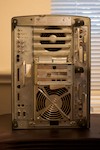Beyond that, I doubt the
own
all the PROM source.
Hardware For Sale/Trade
PMC RM7000C-600T CPUs on ebay - Page 3
Since it's proprietory code, why not? Doesn't make any difference anyway; far as I can tell, it's just not going to happen.
Ian.
Ian.
_________________
SGI Systems/Parts/Spares/Upgrades For Sale: http://www.sgidepot.co.uk/sgidepot/
[email protected] , [email protected] , +44 (0)131 476 0796, check my auctions on eBid!
How about disassembling the PROM, rewriting the CPU initialization code and then reassembling it?
mapesdhs wrote:
PS. I have a slightly different theory. I don't think they even have the PROM source anymore.
That code is closely related to the IRIX kernel code, and some bits are shared between kernel and PROM. I don't think they lost it, but I understand they have issues releasing it

mapesdhs wrote:
mattst88 wrote:
Beyond that, I doubt the own all the PROM source.
Since it's proprietory code, why not?
Propriety has little to do with it. If part of the PROM code is licensed by SGI from a 3rd party, they don't own the copyrights and they they cannot just release it without permission. In the case of the PROM code one such party is almost certainly MIPS. The first CPU boards in the Professional Series were basically OEMed from MIPS, including the PROM, and later IPxx boards were derived from those.
But unfortunately you're certainly right when you say this isn't happening. They will bury every last bit of it, and the IRIX code, rather than releasing it. Sad but true.
ShadeOfBlue wrote:
How about disassembling the PROM, rewriting the CPU initialization code and then reassembling it?
I did that for some of the early systems like IP7 and IP12 and it is a monumental task. There is little reward because you cannot publish your results. I did it because I wanted to learn about the PowerSeries at the very lowest level.
99% of the PROM was originally written in C, so it's not just a matter of disassembling, you basically have to rewrite the matching C code. For a later, much more sophisticated system like an O2, it's not something I would consider doing.
Oh, and I no longer have a computer with the IDApro license, so while I still have the IDA data files they are now useless

_________________
Now this is a deep dark secret, so everybody keep it quiet

It turns out that when reset, the WD33C93 defaults to a SCSI ID of 0, and it was simpler to leave it that way... -- Dave Olson, in comp.sys.sgi
Currently in commercial service:

 (2x)
(2x)

In the museum : almost every MIPS/IRIX system.
Wanted : GM1 board for Professional Series GT graphics (030-0076-003, 030-0076-004)
Its also possible that Microsoft indirectly did some of the SGI PROM development, as they were a major member of the ARC development consortium when originally targetting MIPS boxes with NT (and ARCS seems to be a derivative of ARC). Also, Microsoft were involved closely with MIPS (the company) because the Jazz design used by MIPS Comp. was licensed from them.
There is nothing simple about disassembling and modifying a PROM image either. Cache management is one of the trickiest pieces of code to write normally, let alone disassemble and make fundamental alterations to. And I don't expect many people here have the necessary spec sheet and errata info to write code for these 900MHz+ MIPS CPUs anyway.
There is nothing simple about disassembling and modifying a PROM image either. Cache management is one of the trickiest pieces of code to write normally, let alone disassemble and make fundamental alterations to. And I don't expect many people here have the necessary spec sheet and errata info to write code for these 900MHz+ MIPS CPUs anyway.
kramlq wrote:
... And I don't expect many people here have the necessary spec sheet and errata info to write code for these 900MHz+ MIPS CPUs anyway.
Joe said he could do it but only if he had the original PROM source. He was offered kind help from PMC and Sandcraft
in this regard should the opportunity arise, and IBM gave him some tech help aswell on cache issues. It's perfectly doable,
but for the PROM source. Ah well, plenty of other SGI-related things to occupy our time...
Ian.
mapesdhs wrote:
Joe said he could do it but
only
if he had the original PROM source. He was offered kind help from PMC and Sandcraft in this regard should the opportunity arise, and IBM gave him some tech help aswell on cache issues. It's perfectly doable, but for the PROM source. Ah well, plenty of other SGI-related things to occupy our time...
I wonder what they hope to achieve by this dog in the manger attitude ? I don't mean "release the code ! Free Prommy !" I mean qualified people who are willing to sign non-disclosures. It's a small amount of effort for them in return for a reasonable gain. Yeah, I know, "if it doesn't help the bottom line then in today's economy they can't afford to waste their efforts."
Except it's a helluva lot different story when they want acceptance from the Linux community, when they want to shitcan all the people who paid good money for Irix, when they want something requiring good will and a positive attitude and unpaid efforts from other people (such as a complete free operating system which they planned to use for their own financial advantage, ahem.)
Maybe I'm an idiot optimist. I'd like to believe until proven wrong that the new management is not quite as avaricious and short-sighted as the previous group of proven fools. Perhaps some people inside the new SGI can see the value in having enthusiastic hobbyists doing things to enhance the SGI mystique and reputation.
Perhaps.
mapesdhs wrote:
kramlq wrote:
... And I don't expect many people here have the necessary spec sheet and errata info to write code for these 900MHz+ MIPS CPUs anyway.
Joe said he could do it but only if he had the original PROM source. He was offered kind help from PMC and Sandcraft
in this regard should the opportunity arise, and IBM gave him some tech help aswell on cache issues. It's perfectly doable,
but for the PROM source. Ah well, plenty of other SGI-related things to occupy our time...
Ian.
Yes, but what I mean is that anyone who decides to disassemble and alter the PROM would also have to get the CPU spec sheets via ahem... unofficial channels. If you were to get official access to the CPU specs (e.g. signing an NDA or whatever), and then a few weeks/months later support for that CPU mysteriously gets added into the O2 PROM via reverse engineering .... well it kind of narrows down the field a little if SGI wanted to defend their code/intellectual property rights.
I'm making further adjustments to my storage arrays, and will likely be making available approximately eight 320GB Maxtor MaxLine II (which are a higher grade of IDE drives) ATA-133 IDE drives. Should be some time next week.
My asking price is going to be $30 each, plus figure on another $5 for shipping within the US, or on the order of $15-20 each for international (but ask me for a shipping quote).
Update: Tell you what, let me sweeten the deal, just so I can get rid of these drives sooner rather than later. For an extra $10, I can load up these 320GB IDE drives with my entire ISO collection. I won't go into what's included in a public forum, but let's just say my collection of CD-ROMs go all the way back to the late 80's.
Thanks,
Chris
My asking price is going to be $30 each, plus figure on another $5 for shipping within the US, or on the order of $15-20 each for international (but ask me for a shipping quote).
Update: Tell you what, let me sweeten the deal, just so I can get rid of these drives sooner rather than later. For an extra $10, I can load up these 320GB IDE drives with my entire ISO collection. I won't go into what's included in a public forum, but let's just say my collection of CD-ROMs go all the way back to the late 80's.
Thanks,
Chris
_________________
 (<-EMXI/IO6G)
(<-EMXI/IO6G)


 (<- quad R12k O200 w/GIGAchannel and ESI+Tex) plus a bunch of assorted standalone workstations...
(<- quad R12k O200 w/GIGAchannel and ESI+Tex) plus a bunch of assorted standalone workstations...
Hmmm, pm sent.
_________________
 R4600PC 133 MHz
R4600PC 133 MHz
Mac Mini 2.5GHz 4GB RAM
Raspberry Pi
Dell XPS M1530
bumped for an update...
_________________
 (<-EMXI/IO6G)
(<-EMXI/IO6G)


 (<- quad R12k O200 w/GIGAchannel and ESI+Tex) plus a bunch of assorted standalone workstations...
(<- quad R12k O200 w/GIGAchannel and ESI+Tex) plus a bunch of assorted standalone workstations...
still have a few of these if anyone is interested?>
The Keeper wrote:
XR52 and XR55 sounds to me like Xyratex. Xyratex, from what I recall, doesn't play silly games with the sector size, so I would be willing to wager that the drives you have there are either "normal" or can be made "normal" with a small amount of effort using Seagate's SeaTools Enterprise Edition (free download from Seagate).
Chris
Chris
You can actually do it under Irix with fx as well. You go in and change the geometry from 520 to 512 byte sectors and the Low level them. It seems to take less than 20 mins. I did three NetApp trays at the same time by opening fx for each drive. It was a pleasent suprise last weekend as I thought I was going to have to spend a week doing it a drive at a time.
_________________
Patrick
- That's what she said -
Wait. You converted netapp disks into silly regular drives? I've got loads of regular drives and 3 netapps without drives. Netapp firmware drives don't grow on trees ...
_________________




Anyway, there are plenty of RM7000C-600T bare CPUs available in china

I managed to get me a tray of these (27) and can offer more 600MHz rework.
For all who don´t know: *only* R5271 O2 CPU modules are suited for this.
No, I do *not* have complete modules for sale - these babies are rare
But I do have some O2 600MHz modules which behave quite strange!
E. g. one does pass all IDE tests (invoked from PROM monitor, lengthy!)
without a single error message, but IRIX boots directly into shutdown:
from "stop for maintenance" into "ok to power down", nothing in between.

I managed to get me a tray of these (27) and can offer more 600MHz rework.
For all who don´t know: *only* R5271 O2 CPU modules are suited for this.
No, I do *not* have complete modules for sale - these babies are rare

But I do have some O2 600MHz modules which behave quite strange!
E. g. one does pass all IDE tests (invoked from PROM monitor, lengthy!)
without a single error message, but IRIX boots directly into shutdown:
from "stop for maintenance" into "ok to power down", nothing in between.
_________________
Valueing life is not weakness; disregarding it is not strength. -Mirage-

edefault wrote:
For all who don´t know: *only* R5271 O2 CPU modules are suited for this.
No, I do *not* have complete modules for sale - these babies are rare
No, I do *not* have complete modules for sale - these babies are rare

For those who don't have an R5K/300 module, I still have five complete R7K/600 modules available.
Ian.
I'll repost here, since no one saw it or responded in the other thread.
Subject: o2 R7k 600MHz 1GB
I've found some pretty readily available parts that use the following cache chips in capacities of 1MB (and 2MB I think, but I cannot confirm)
Also, in another system in capacities of 1MB:
Also, in a system identical to System 2 in capacities of 1MB:
Are these usable in the O2 CPU modding project? Are these the chips that are 50% faster?
I hope that knowing that the Motorola chip is available makes this project more do-able.
I'm not ready to divulge where these chips can be found, out of fear of people scalping this hardware for its cache chips.
Subject: o2 R7k 600MHz 1GB
omelett wrote:
thats a good hint!
here the part nr. of the L3 cache chip out of my box :
ibm 9314
84364BSLAC
81L3394 7
A07043XT PQ
anyway, we start again for a O2 speedup, thanks much!!!!!!!!!!!!!!!!!!!!!!!!!!!!!!!!!!!!!!!!!!!!!

omelett
here the part nr. of the L3 cache chip out of my box :
ibm 9314
84364BSLAC
81L3394 7
A07043XT PQ
anyway, we start again for a O2 speedup, thanks much!!!!!!!!!!!!!!!!!!!!!!!!!!!!!!!!!!!!!!!!!!!!!

omelett
I've found some pretty readily available parts that use the following cache chips in capacities of 1MB (and 2MB I think, but I cannot confirm)
Cache from System 1 wrote:
IBM 9314
041841QLAD
01L4989 5
U33096XT PQ
041841QLAD
01L4989 5
U33096XT PQ
Also, in another system in capacities of 1MB:
Cache from System 2 wrote:
IBM 9314
041841QLAD
01L4988 4
U29008XT PQ
041841QLAD
01L4988 4
U29008XT PQ
Also, in a system identical to System 2 in capacities of 1MB:
Cache from System 3 wrote:
Motorola (the M with a circle around it)
MCM69R818AZP5
QQQAC9842
TNRXQ
MCM69R818AZP5
QQQAC9842
TNRXQ
Are these usable in the O2 CPU modding project? Are these the chips that are 50% faster?
I hope that knowing that the Motorola chip is available makes this project more do-able.
I'm not ready to divulge where these chips can be found, out of fear of people scalping this hardware for its cache chips.
I got one of these, there's lots of fun stuff on here... still 5 or 6 left.
_________________
 (Maradona)
(Maradona)
 (DavidVilla) A1186 (Xavi) d800 (Pique) d820 (Neymar)
(DavidVilla) A1186 (Xavi) d800 (Pique) d820 (Neymar)
A1370 (Messi) dp43tf (Puyol) A1387 (Abidal) A1408 (Guardiola)
If you have 28 of these drives, and want to get rid of it, I"d take it for 50USD per drive.
And by the way, I have here NetApp 2GBit arrays (xyratex rf-1400 ripoff), do they need special (netapp blessed) drives?
And by the way, I have here NetApp 2GBit arrays (xyratex rf-1400 ripoff), do they need special (netapp blessed) drives?
_________________




The diskboxes don't, if you want to run them as JBOD on software RAID or whatever OS you point at it.
However, if you have a NetApp filer head you absolutely require NetApp approved firmware on them for them to work, otherwise your filer will shutdown in 24 hours. There are certain Seagate and Hitachi models out there which can be flashed to NetApp firmware for them to work on NetApp NAS filers, but currently only Seagate models seem to be successful.
However, if you have a NetApp filer head you absolutely require NetApp approved firmware on them for them to work, otherwise your filer will shutdown in 24 hours. There are certain Seagate and Hitachi models out there which can be flashed to NetApp firmware for them to work on NetApp NAS filers, but currently only Seagate models seem to be successful.
_________________













